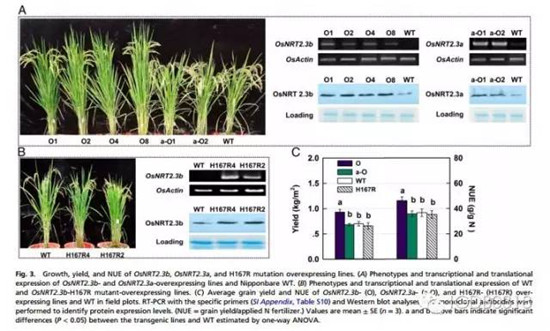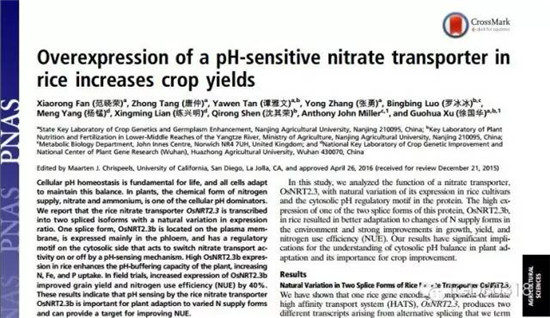科学家发现能促进水稻增产50%的蛋白
最近,来自英国John Innes Centre中心的Anthony John Miller与国内的南京农业大学徐国华(Guohua Xu)教授合作,在最近6月6日的《PNAS》中刊登了一篇题为《PH敏感型氮素转运蛋白的过表达能促进作物产量的提高》文章,文章指出,“耕作水稻如果能改善对其自身的PH水平,就能保证其从土壤吸收更多的氮、铁和磷酸盐营养物质,从而使水稻有望增产到54%”。

水稻作为最重要的粮食之一,养活了世界上50%的人口,同时保留对周围环境变化的生存能力。水稻在浸水、缺氧的环境下生长环境更有利于铵态的氮积累。而干旱的土壤条件下,土壤含氧的增加,则有利于硝态氮的聚集。因此,氮肥的作为最重要投入成本,它的过度投入对环境有负面的效应。
氮素通常被植物根系吸收利用有2种形式,硝态氮和铵态氮。对于植物而言,前者吸收太多,导致植物细胞酸化,而后者吸收太多在,则植物细胞碱化。因此,它们任何一种氮素形式吸收都会影响植物PH的平衡、导致酶工作的失常、从而影响植物健康和作物产量。

水稻包含了一个编码参与氮素运输的OsNRT2.3基因,该基因具有2个剪切版本,OsNRT2.3a和OsNRT2.3b, 对于OsNRT2.3b而言,它能控制氮素运输的开启和关闭,依赖于植物细胞PH值。当‘b’蛋白过表达时,有利于对抗植物体内PH的变化。这有利于其吸收更多的氮、铁、磷等元素。因而,有利于NUE(氮素利用率)提高到40%,而水稻产量增加到54%以上。该特殊蛋白的发现极大地促进氮素利用率和产量的提高,因此,有利于育种家培养出产量高、环境危害小的水稻或其他作物新品种。
Underlying article: http://dx.doi.org/10.1073/pnas.1525184113

Overexpression of a pH-sensitive nitrate transporter in rice increases crop yields
Abstract
Cellular pH homeostasis is fundamental for life, and all cells adapt to maintain this balance. In plants, the chemical form of nitrogen supply,nitrate and ammonium, is one of the cellular pH dominators. We report that the rice nitrate transporter OsNRT2.3 is transcribed into two spliced isoforms with a natural variation in expression ratio. One splice form, OsNRT2.3b is located on the plasma membrane, is expressed mainly in the phl-oem, and has a regulatory motif on the cytosolic side that acts to switch nitrate transport activity on or off by a pH-sensing mechanism. High OsNRT2.3b expression in rice enhances the pH-buffering capacity of the plant, increasing N, Fe, and P uptake. In field trials, increased expression of OsNRT2.3b improved grain yield and nitrogen use efficiency (NUE) by 40%. These results indicate that pH sensing by the rice nitrate transporter OsNRT2.3b is important for plant adaption to varied N supply forms and can provide a target for improving NUE.

